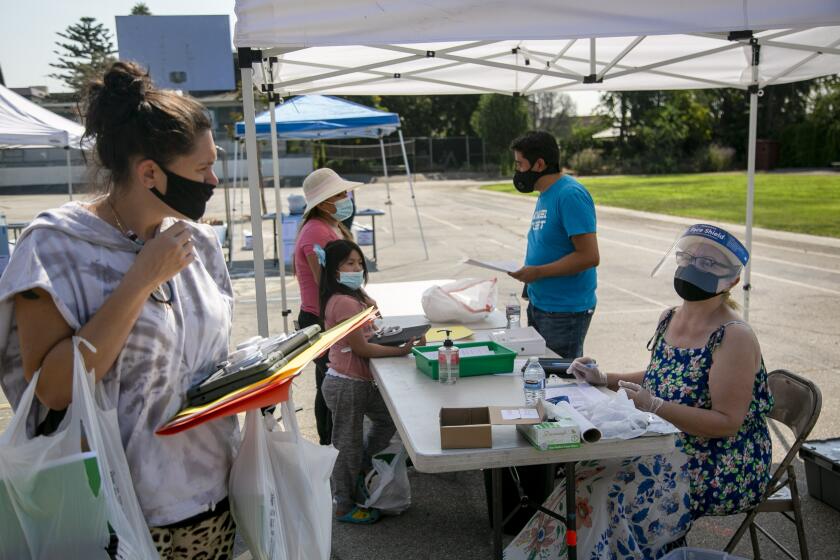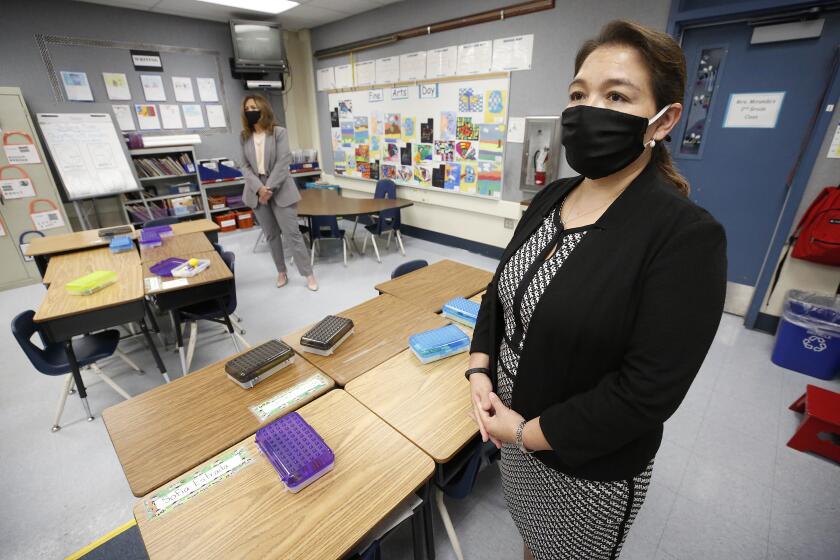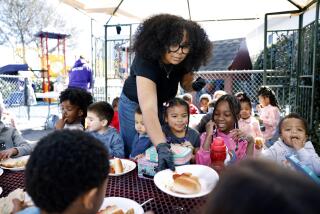Zoom overload, COVID-19 hardship: Thousands of kindergartners are no-shows at local schools

- Share via
Kindergarten enrollment is down sharply in Los Angeles public schools and elsewhere, signaling that many parents of the state’s youngest students face heavy burdens with online learning and may be opting out of traditional public schools or moving out of L.A. amid the coronavirus crisis.
The drop of 6,000 kindergarten students in the nation’s second-largest school district represents a 14% decline since last year. When combined with anecdotal reports of inconsistent kindergarten attendance in live online classes, some virtual classrooms appear to be at about 50% to 75% capacity.
Since campuses shut in mid-March, experts have expressed particular concern over 4-, 5- and 6-year-old students, who are missing out on critical socialization skills with other children, may be struggling to form important bonds with teachers and lack the developmental stamina to stay engaged for extended periods of computer learning.
Educators worry that the most disadvantaged children will be left further behind.
“If these families are disproportionately losing access to kindergarten, then it is likely that there will be downstream impacts on their learning when they have to catch up to children who both began school with greater advantages and had that opportunity for formal learning in kindergarten,” said Anna Markowitz, an assistant professor of education at UCLA.
It’s too early for a precise picture of why kindergarten enrollment has dropped so dramatically. But L.A. schools Supt. Austin Beutner said there’s a correlation in L.A. Unified between enrollment decline and communities already hard hit by coronavirus illness and economic hardship. The L.A. Unified student population is 80% Latino, with nearly the same percentage of children in need of free or reduced-price meals.
Principals and district officials are concerned about enrollment numbers in the L.A. Unified School District, especially among the youngest students.
“The biggest drops in kindergarten enrollment are generally in neighborhoods with the lowest household incomes,” Beutner said during a pre-recorded Monday online briefing. “We suspect some of this is because families may lack the ability to provide full-time support at home for online learning, which is necessary for very young learners.”
Parents’ struggles can become intense.
Isabel Lopez — mother to a toddler, a first-grader, a fifth-grader and an eighth-grader — spends the entire school day guiding children through classes from her home in downtown L.A.
First-grader Rosie sometimes breaks down in tears. She gets frustrated when she can’t tell if her teacher sees when she raises her hand to answer a question.
Alyssa McGregor, the mother of seven children, six in school, said it’s been especially challenging keeping her twin girls, in transitional kindergarten, focused. Transitional kindergarten serves 4-year-olds who turn 5 during the fall semester.
McGregor, who lives in South LA, said the girls need help using their tablets and she often finds them wandering around, hoping to see what their siblings are doing.
“I have to constantly tell them: ‘Stay out of your sisters’ class,’” said McGregor, who also has to manage a 5-month-old. “If they were in the classroom setting, I think it would be a lot different.”
Under state law, parents do not have to enroll their children in kindergarten. Starting in first grade, however, schooling is mandatory, although parents are allowed to homeschool their children.
The majority of California school districts are located in counties with widespread transmission rates and are unable to open under Gov. Gavin Newsom’s four-tier system. Elementary schools are still able to seek waivers with county approval.
Katie Pace, a parent leader at Gardner Elementary in Hollywood, said early tallies put attendance down 10% to 15%, despite a well-regarded principal and a stable, veteran staff.
“Everyone just left the city mostly” for economic reasons, Pace said of the departures she knew about.
Other parents seem to be opting out.
One said he moved his daughter — who is starting first grade — from an L.A. Unified school on the Westside to a private school in the expectation that it would reopen sooner. The parent asked that his name not be used out of respect for his daughter’s privacy.
A principal in southwest L.A. said her enrollment drop is related to serving a low-income minority community slammed by COVID-19.
“It doesn’t surprise me that parents are unwilling to take the risk of putting a 5-year-old on a campus and also are not comfortable with a 5-year-old sitting in front of a computer for a half or a full day,” said the principal, who requested anonymity because she was not authorized to speak.
“Honestly, I probably wouldn’t enroll my children in kindergarten right now,” she said. “Or, if I had to work, I would look at private options.” She added that L.A. Unified is treating kindergartners too much like 12th-graders in terms of time spent online.
In addition to the drop in kindergarten, some principals are reporting declines in enrollment — and in meaningful student participation — in transitional kindergarten and first grade.
“The average class size is approximately 12 to 15 students per grade level,” said Juan Flecha, president of the union that represents principals, who based his estimate on feedback from his members. “I think parents are finding it extraordinarily difficult to manage their personal and professional lives while somehow keeping the tykes engaged on a device.”
Some parents have formed learning co-ops with other families, sometimes pooling money to hire a private teacher.
The issue of vanished students is far from unique to L.A. Unified.
Las Virgenes Unified Supt. Dan Stepenosky said his school district is down 490 students — including about 100 kindergartners — to an enrollment of 10,329. The drop was 230 greater than projections for the school system, which straddles the border of L.A. and Ventura counties and serves an enrollment that is more prosperous on average than that of L.A. Unified.
“We’re hearing that lots of preschools added kinder so the families are staying there,” Stepenosky said. “We’re also hearing about a lot of ‘camps’ that are mostly like classroom instruction. I also think we have had families move. Some moved because of the Woolsey fire — we still have 400 homes that have not been replaced. People are tired of California.”
He said he’s hopeful that families put off by excessive “Zoom time” will return once campuses reopen, an optimism shared by Burbank Supt. Matt Hill, where kindergarten enrollment also is down.
In Pomona, where about 9 in 10 students are part of low-income households, some families are moving east to reduce their living costs, even while holding on to poverty-wage jobs in Los Angeles that are now more difficult to get to.
“But now, instead of driving from Pomona, they’re driving from Ontario or Fontana or further down the road,” said district spokesman Oliver Unaka.
Audrey Smith, a teacher at Gonsalves Elementary in ABC Unified, said her southeast L.A. County school is down to two kindergarten classrooms from three. And her transitional kindergarten class, normally full, is down four students. High housing costs in Cerritos are largely the reason for the school’s ongoing enrollment decline, but online learning has exacerbated the trend.
Some parents question the worth of online education versus “what you’d find in a classroom where children are socializing, playing with blocks, learning how to take turns and sharing and making friends,” Smith said.
In L.A. Unified, overall enrollment has been trending downward for years and the drop across all grades is not far from projections. This year’s pre-COVID predicted enrollment was 463,539. The current number is 461,105 — and that figure could rise before the district’s official “census” day, about five weeks into the year.
But the 6,000-student drop in kindergarten was three times as large as projected.
L.A. Unified publicly released some enrollment figures Monday after The Times repeatedly requested them — and the district repeatedly refused to supply them, suggesting that the newspaper wait until the district officially compiled data later in the year.
For the moment it’s difficult to track meaningful student attendance and engagement from the outside because L.A. Unified has taken full advantage of the state’s liberal attendance guidelines. Students are to be counted as present for a day of school no matter how minimal the contact between a teacher and student — as long as that interaction occurs on the day that attendance is taken.
McGregor, the mother of the 4-year-old twins, doesn’t fault the school for the challenges she faces keeping small children online and on task. Unlike many parents, she hasn’t opted out, moved out or given up, but there are limits.
“I don’t plan to take them out unless they say this is going to be a lifestyle forever,” she said. “Then, yeah, I would take them out.”
Times staff writer Julia Barajas contributed to this report.
More to Read
Sign up for Essential California
The most important California stories and recommendations in your inbox every morning.
You may occasionally receive promotional content from the Los Angeles Times.















